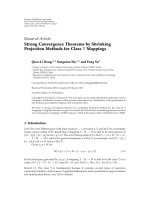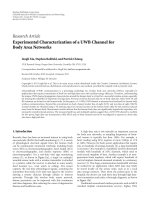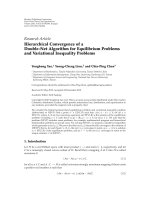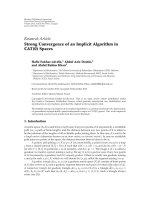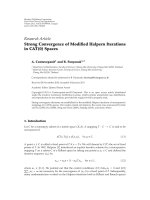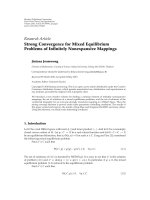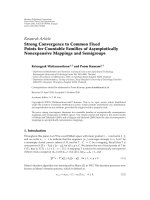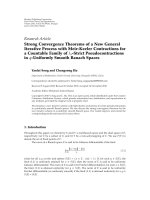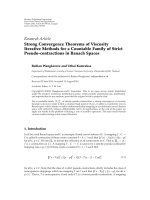Báo cáo hóa học: " Research Article Strong Convergence of Monotone Hybrid Algorithm for Hemi-Relatively Nonexpansive Mappings" potx
Bạn đang xem bản rút gọn của tài liệu. Xem và tải ngay bản đầy đủ của tài liệu tại đây (475.76 KB, 8 trang )
Hindawi Publishing Corporation
Fixed Point Theory and Applications
Volume 2008, Article ID 284613, 8 pages
doi:10.1155/2008/284613
Research Article
Strong Convergence of Monotone Hybrid Algorithm
for Hemi-Relatively Nonexpansive Mappings
Yongfu Su,
1
Dongxing Wang,
1
and Meijuan Shang
1, 2
1
Department of Mathematics, Tianjin Polytechnic University, Tianjin 300160, China
2
Department of Mathematics, Shijiazhuang University, Shijiazhuang 050035, China
Correspondence should be addressed to Yongfu Su,
Received 1 June 2007; Revised 5 September 2007; Accepted 16 October 2007
Recommended by Simeon Reich
The purpose of this article is to prove strong convergence theorems for fixed points of closed hemi-
relatively nonexpansive mappings. In order to get these convergence theorems, the monotone hy-
brid iteration method is presented and is used to approximate those fixed points. Note that the
hybrid iteration method presented by S. Matsushita and W. Takahashi can be used for relatively
nonexpansive mapping, but it cannot be used for hemi-relatively nonexpansive mapping. The re-
sults of this paper modify and improve the results of S. Matsushita and W. Takahashi 2005,and
some others.
Copyright q 2008 Yongfu Su et al. This is an open access article distributed under the Creative
Commons Attribution License, which permits unrestricted use, distribution, and reproduction in
any medium, provided the original work is properly cited.
1. Introduction
In 2005, Shin-ya Matsushita and Wataru Takahashi 1 proposed the following hybrid iteration
method it is also called the CQ method with generalized projection for relatively nonexpan-
sive mapping T in a Banach space E:
x
0
∈ C chosen arbitrarily,
y
n
J
−1
α
n
Jx
n
1 − α
n
JTx
n
,
C
n
z ∈ C : φ
z, y
n
≤ φ
z, x
n
,
Q
n
z ∈ C : x
n
− z, Jx
0
− Jx
n
≥0
,
x
n1
Π
C
n
∩Q
n
x
0
.
1.1
They proved the following convergence theorem.
2 Fixed Point Theory and Applications
Theorem 1.1 MT. Let E be a uniformly convex and uniformly smooth real Banach space, let C be a
nonempty, closed, and convex subset of E,letT be a relatively nonexpansive mapping from C into itself,
and let {α
n
} be a sequence of real numbers such that 0 ≤ α
n
< 1 and lim sup
n→∞
α
n
< 1. Suppose
that {x
n
} is given by 1.1,whereJ is the duality mapping on E. If the set FT of fixed points of T is
nonempty, then {x
n
} converges strongly to Π
FT
x
0
,whereΠ
FT
· is the generalized projection from
C onto FT.
The purpose of this article is to prove strong convergence theorems for fixed points of
closed hemi-relatively nonexpansive mappings. In order to get these convergence theorems,
the monotone hybrid iteration method is presented and is used to approximate those fixed
points. Note that the hybrid iteration method presented by S.Matsushita and W. Takahashi can
be used for relatively nonexpansive mapping, but it cannot be used for hemi-relatively non-
expansive mapping. The results of this paper modify and improve the results of S.Matsushita
and W. Takahashi 1, and some others.
2. Preliminaries
Let E be a real Banach space with dual E
∗
.WedenotebyJ the normalized duality mapping
from E to 2
E
∗
defined by
Jx
f ∈ E
∗
: x, f x
2
f
2
, 2.1
where ·, · denotes the generalized duality pairing. It is well known that if E
∗
is uniformly
convex, then J is uniformly continuous on bounded subsets of E. In this case, J is singe valued
and also one to one.
Recall that if C is a nonempty, closed, and convex subset of a Hilbert space H and P
C
:
H → C is the metric projection of H onto C,thenP
C
is nonexpansive. This is true only when
H is a real Hilbert space. In this connection, Alber 2 has recently introduced a generalized
projection operator Π
C
in a Banach space E which is an analogue of the metric projection in
Hilbert spaces.
Next, we assume that E is a smooth Banach space. Consider the functional defined as
2, 3 by
φx, yx
2
− 2x, Jy y
2
for x, y ∈ E. 2.2
Observe that, in a Hilbert space H, 2.2 reduces to φx, yx − y
2
, x, y ∈ H.
The generalized projection Π
C
: E → C is a map that assigns to an arbitrary point x ∈ E
the minimum point of the functional φy, x, that is, Π
C
x x, where x is the solution to the
minimization problem
φ
x, xmin
y∈C
φy, x, 2.3
existence and uniqueness of the operator Π
C
follow from the properties of the functional
φy, x and strict monotonicity of the mapping J see, e.g., 2–4. In Hilbert space, Π
C
P
C
. It
is obvious from the definition of the function φ that
y−x
2
≤ φy, x ≤
y x
2
∀x, y ∈ E. 2.4
Yongfu Su et al. 3
Remark 2.1. If E is a reflexive strict convex and smooth Banach space, then for x, y ∈ E, φx, y
0 if and only if x y.Itissufficient to show that if φx, y0, then x y.From2.4,wehave
x y. This implies x, Jy x
2
Jy
2
. From the definition of J, we have Jx Jy,that
is, x y; see 5 for more details.
We refer the interested reader to the 6, where additional information on the duality
mapping may be found.
Let C be a closed convex subset of E, and Let T be a mapping from C into itself.
We denote by FT the set of fixed points of T. T is called hemi-relatively nonexpansive if
φp, Tx ≤ φp, x for all x ∈ C and p ∈ FT.
A point p in C is said to be an asymptotic fixed point of T 7 if C contains a sequence {x
n
}
which converges weakly to p such that the strong lim
n→∞
Tx
n
− x
n
0. The set of asymptotic
fixed points of T will be denoted by
FT. A hemi-relatively nonexpansive mapping T from C
into itself is called relatively nonexpansive 1, 7, 8 if
FTFT.
We need the following lemmas for the proof of our main results.
Lemma 2.2 Kamimura and Takahashi 4, 1, Proposition 2.1. Let E be a uniformly convex and
smooth real Banach space and let {x
n
}, {y
n
} be two sequences of E.Ifφx
n
,y
n
→ 0 and either {x
n
}
or {y
n
} is bounded, then x
n
− y
n
→0.
Lemma 2.3 Alber 2, 1, Proposition 2.2. Let C be a nonempty c losed convex subset of a smooth
real Banach space E and x ∈ E.Then,x
0
Π
C
x if and only if
x
0
− y, Jx − Jx
0
≥ 0 ∀y ∈ C. 2.5
Lemma 2.4 Alber 2, 1, Proposition 2.3. Let E be a reflexive, strict convex, and smooth real
Banach space, let C be a nonempty closed convex subset of E and let x ∈ E. Then
φ
y, Π
c
x
φ
Π
c
x, x
≤ φy, x ∀y ∈ C. 2.6
By using the similar method as 1, Proposition 2.4, the following lemma is not hard to
prove.
Lemma 2.5. Let E be a strictly convex and smooth real Banach space, let C be a closed convex subset
of E, and let T be a hemi-relatively nonexpansive mapping from C into itself. Then FT is closed and
convex.
Recall that an operator T in a Banach space is called closed, if x
n
→ x, Tx
n
→ y,then
Tx y.
3. Strong convergence for hemi-relatively nonexpansive mappings
Theorem 3.1. Theorem 3.1 Let E be a uniformly convex and uniformly smooth real Banach space, let
C be a nonempty closed convex subset of E,letT : C → C be a closed hemi-relatively nonexpansive
mapping such that FT
/
∅. Assume that {α
n
} is a sequence in 0, 1 such that lim sup
n→∞
α
n
< 1.
Define a sequence {x
n
} in C by the following algorithm:
4 Fixed Point Theory and Applications
x
0
∈ C chosen arbitrarily,
y
n
J
−1
α
n
Jx
n
1 − α
n
JTx
n
,
C
n
z ∈ C
n−1
∩ Q
n−1
: φ
z, y
n
≤ φ
z, x
n
,
C
0
z ∈ C : φ
z, y
0
≤ φ
z, x
0
,
Q
n
z ∈ C
n−1
∩ Q
n−1
:
x
n
− z, Jx
0
− Jx
n
≥ 0
,
Q
0
C,
x
n1
Π
C
n
∩Q
n
x
0
,
3.1
where J is the duality mapping on E.Then{x
n
} converges strongly to Π
FT
x
0
,whereΠ
FT
is the
generalized projection from C onto FT.
Proof. We first show that C
n
and Q
n
are closed and convex for each n ≥ 0. From the definition
of C
n
and Q
n
, it is obvious that C
n
is closed and Q
n
is closed and convex for each n ≥ 0. We
show that C
n
is convex for any n ≥ 0. Since
φ
z, y
n
≤ φ
z, x
n
3.2
is equivalent to
2
z, Jx
n
− Jy
n
≤
x
n
2
−
y
n
2
, 3.3
it follows that C
n
is convex.
Next, we show that FT ⊂ C
n
for all n ≥ 0. Indeed, we have for all p ∈ FT that
φ
p, y
n
φ
p, j
−1
α
n
jx
n
1 − α
n
jtx
n
≤p
2
− 2
p, α
n
jx
n
1 − α
n
jtx
n
α
n
x
n
2
1 − α
n
tx
n
2
α
n
φ
p, x
n
1 − α
n
φ
p, tx
n
≤ α
n
φ
p, x
n
1 − α
n
φ
p, x
n
φ
p, x
n
.
3.4
That is, p ∈ C
n
for all n ≥ 0.
Next, we show that FT ⊂ Q
n
for all n ≥ 0, we prove this by induction. For n 0, we
have FT ⊂ C Q
0
. Assume that FT ⊂ Q
n
. Since x
n1
is the projection of x
0
onto C
n
∩ Q
n
,by
Lemma 2.3,wehave
x
n1
− z, Jx
0
− Jx
n1
≥ 0, ∀z ∈ C
n
∩ Q
n
. 3.5
As FT ⊂ C
n
∩ Q
n
by the induction assumptions, the last inequality holds, in particular, for all
z ∈ FT. This together with the definition of Q
n1
implies that FT ⊂ Q
n1
.
Since x
n1
Π
C
n
∩Q
n
x
0
and C
n
∩Q
n
⊂ C
n−1
∩Q
n−1
for all n ≥ 1, we have
φ
x
n
,x
0
≤ φ
x
n1
,x
0
3.6
for all n ≥ 0. Therefore, {φx
n
,x
0
} is nondecreasing. In addition, it follows from the definition
of Q
n
and Lemma 2.3 that x
n
Π
Q
n
x
0
. Therefore, by Lemma 2.4,wehave
φ
x
n
,x
0
φ
Π
Q
n
x
0
,x
0
≤ φ
p, x
0
− φ
p, x
n
≤ φ
p, x
0
, 3.7
Yongfu Su et al. 5
for each p ∈ FT ⊂ Q
n
for all n ≥ 0. Therefore, φx
n
,x
0
is bounded, this together with 3.6
implies that the limit of {φx
n
,x
0
} exists. Put
lim
n→∞
φ
x
n
,x
0
d. 3.8
From Lemma 2.4, we have, for any positive integer m,that
φ
x
nm
,x
n
φ
x
nm
, Π
C
n
x
0
≤ φ
x
nm
,x
0
− φ
Π
C
n
x
0
,x
0
φ
x
nm
,x
0
− φ
x
n
,x
0
,
3.9
for all n ≥ 0. Therefore,
lim
n→∞
φ
x
nm
,x
n
0. 3.10
We claim that {x
n
} is a Cauchy sequence. If not, there exists a positive real number ε
0
> 0
and subsequence {n
k
}, {m
k
}⊂{n} such that
x
n
k
m
k
− x
n
k
≥ ε
0
, 3.11
for all k ≥ 1.
On the other hand, from 3.8 and 3.9 we have
φ
x
n
k
m
k
,x
n
k
≤ φ
x
n
k
m
k
,x
0
− φ
x
n
k
,x
0
≤
φ
x
n
k
m
k
,x
0
− d
|d − φ
x
n
k
,x
0
|−→0,k−→ ∞ .
3.12
Because from 3.8 we know that φx
n
,x
0
is bounded, this and 2.4 imply that {x
n
} is also
bounded, so by Lemma 2.2 we obtain
lim
k→∞
x
n
k
m
k
− x
n
k
0. 3.13
This is a contradiction, so that {x
n
} is a Cauchy sequence, therefore there exists a point p ∈ C
such that {x
n
} converges strongly to p.
Since x
n1
Π
C
n
∩Q
n
x
0
∈ C
n
, from the definition of C
n
,wehave
φ
x
n1
,y
n
≤ φ
x
n1
,x
n
. 3.14
It follows from 3.10, 3.14 that
φ
x
n1
,y
n
−→ 0. 3.15
By using Lemma 2.2,wehave
lim
n→∞
x
n1
− y
n
lim
n→∞
x
n1
− x
n
0. 3.16
6 Fixed Point Theory and Applications
Since J is uniformly norm-to-norm continuous on bounded sets, we have
lim
n→∞
Jx
n1
− Jy
n
lim
n→∞
Jx
n1
− Jx
n
0. 3.17
Noticing that
Jx
n1
− Jy
n
Jx
n1
−
α
n
Jx
n
1 − α
n
JTx
n
α
n
Jx
n1
− Jx
n
1 − α
n
Jx
n1
− JTx
n
1 − α
n
Jx
n1
− Jtx
n
− α
n
Jx
n
− Jx
n1
≥
1 − α
n
Jx
n1
− Jtx
n
− α
n
Jx
n
− Jx
n1
,
3.18
which implies that
Jx
n1
− JTx
n
≤
1
1 − α
n
Jx
n1
− Jy
n
α
n
Jx
n
− Jx
n1
. 3.19
This together with 3.17 and lim sup
n→∞
α
n
< 1 implies that
lim
n→∞
Jx
n1
− JTx
n
0. 3.20
Since J
−1
is also uniformly norm-to-norm continuous on any bounded sets, we have
lim
n→∞
x
n1
− Tx
n
0. 3.21
Observe that
x
n
− Tx
n
≤
x
n
− x
n1
x
n1
− Tx
n
. 3.22
It follows from 3.16 and 3.21 that
lim
n→∞
x
n
− Tx
n
0. 3.23
Since T is a closed operator and x
n
→ p,thenp is a fixed point of T.
Finally, we prove that p Π
FT
x
0
.FromLemma 2.4,wehave
φ
p, Π
FT
x
0
φ
Π
FT
x
0
,x
0
≤ φ
p, x
0
. 3.24
On the other hand, since x
n1
Π
C
n
∩Q
n
and C
n
∩Q
n
⊃ FT, for all n,wegetfromLemma 2.4
that
φ
Π
FT
x
0
,x
n1
φ
x
n1
,x
0
≤ φ
Π
FT
x
0
,x
0
. 3.25
By the definition of φx, y, it follows that both φp, x
0
≤ φΠ
FT
x
0
,x
0
and φp, x
0
≥
φΠ
FT
x
0
,x
0
, whence φp, x
0
φΠ
FT
x
0
,x
0
. Therefore, it follows from the uniqueness of
Π
FT
x
0
that p Π
FT
x
0
. This completes the proof.
Yongfu Su et al. 7
Theorem 3.2. Let E be a uniformly convex and uniformly smooth real Banach space, let C be a
nonempty, closed, and convex subset of E, and let T : C → C be a closed relative nonexpansive
mapping such that FT
/
∅. Assume that {α
n
} is a sequences in 0, 1 such that lim sup
n→∞
α
n
< 1.
Define a sequence {x
n
} in C by the following algorithm:
x
0
∈ C chosen arbitrarily,
y
n
J
−1
α
n
Jx
n
1 − α
n
JTx
n
,
C
n
z ∈ C
n−1
∩ Q
n−1
: φ
z, y
n
≤ φ
z, x
n
,
C
0
z ∈ C : φ
z, y
0
≤ φ
z, x
0
,
Q
n
z ∈ C
n−1
∩ Q
n−1
:
x
n
− z, Jx
0
− Jx
n
≥ 0
,
Q
0
C,
x
n1
Π
C
n
∩Q
n
x
0
,
3.26
where J is the duality mapping on E.Then{x
n
} converges strongly to Π
FT
x
0
,whereΠ
FT
is the
generalized projection from C onto FT.
Proof. Since every relatively nonexpansive mapping is a hemi-relatively one, Theorem 3.2 is
implied by Theorem 3.1.
Remark 3.3. In recent years, the hybrid iteration methods for approximating fixed points of
nonlinear mappings have been introduced and studied by various authors 1, 8–11. In fact, all
hybrid iteration methods can be replaced or modified by monotone hybrid iteration methods,
respectively. In addition, by using the monotone hybrid method we can easily show that the
iteration sequence {x
n
} is a Cauchy sequence, without the use of the Kadec-Klee property,
demiclosedness principle, and Opial’s condition or other methods which make use of the weak
topology.
Acknowledgments
The authors would like to thank the referee for valuable suggestions which h elped to improve
this manuscript. This project is supported by the National Natural Science Foundation of China
under Grant no. 10771050.
References
1 S Y. Matsushita and W. Takahashi, “A strong convergence theorem for relatively nonexpansive map-
pings in a banach space,” Journal of Approximation Theory, vol. 134, no. 2, pp. 257–266, 2005.
2 Ya. I. Alber, “Metric and generalized projection operators in Banach spaces: properties and applica-
tions,” in Theory and Applications of Nonlinear Operators of Accretive and Monotone Type,A.G.Kartsatos,
Ed., vol. 178 of Lecture Notes in Pure and Appl. Math., pp. 15–50, Marcel Dekker, New York, NY, USA,
1996.
3 Ya. I. Alber and S. Reich, “An iterative method for solving a class of nonlinear operator equations in
Banach spaces,” PanAmerican Mathematical Journal, vol. 4, no. 2, pp. 39–54, 1994.
4 S. Kamimura and W. Takahashi, “Strong convergence of a proximal-type algorithm in a Banach space,”
SIAM Journal on Optimization, vol. 13, no. 3, pp. 938–945, 2002.
5 I. Cioranescu, Geometry of Banach Spaces, Duality Mappings and Nonlinear Problems,vol.62ofMathemat-
ics and Its Applications, Kluwer Academic, Dordrecht, The Netherlands, 1990.
8 Fixed Point Theory and Applications
6 S. Reich, “Review of geometry of Banach spaces, duality mappings and nonlinear problems by Ioana
Cioranescu,” Bulletin of the American Mathematical Society, vol. 26, pp. 367–370, 1992.
7 D. Butnariu, S. Reich, and A. J. Zaslavski, “Asymptotic behavior of relatively nonexpansive operators
in Banach spaces,” Journal of Applied Analysis, vol. 7, no. 2, pp. 151–174, 2001.
8 C. Martinez-Yanes and H K. Xu, “Strong convergence of the CQ method for fixed point iteration
processes,” Nonlinear Analysis: Theory, Methods & Applications, vol. 64, no. 11, pp. 2400–2411, 2006.
9 T H. Kim and H K. Xu, “Strong convergence of modified Mann iterations for asymptotically nonex-
pansive mappings and semigroups,” Nonlinear Analysis: Theory, Methods & Applications,vol.64,no.5,
pp. 1140–1152, 2006.
10 K. Nakajo and W. Takahashi, “Strong convergence theorems for nonexpansive mappings and non-
expansive semigroups,” Journal of Mathematical Analysis and Applications, vol. 279, no. 2, pp. 372–379,
2003.
11 X. Qin and Y. Su, “Strong convergence theorems for relatively nonexpansive mappings in a banach
space,” Nonlinear Analysis: Theory, Methods & Applications, vol. 67, no. 6, pp. 1958–1965, 2007.
